For many people, the main purpose in visiting Siem Reap is to see the great temples of Angkor. Hidden in the Cambodian jungle for centuries, the ruins of Angkor were discovered only in 1861. Does the sound of a “lost civilisation” appeal to you? It certainly exudes an element of mystery, prompting hordes of tourists to visit it everyday!
With hundreds of temples sprawled over the vast city of Angkor, a UNESCO World Heritage Site, we dedicated two days to check out the more prominent monuments. Our first day of temple-sightseeing was dedicated to the two must-sees: Angkor Wat and the Bayon at Angkor Thom.
Determined to catch a glimpse of Angkor Wat at sunrise, we set out when the sky was still dark. Of course, Mr. Sohmat was ready to send us there in his trusty tuk-tuk.
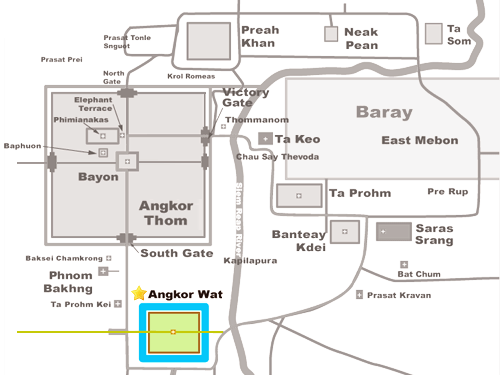
(I put up this little map, marked with our location, so that you can easily trace our journey through the various Angkor temples.)
We bought a 1-day pass for US$20 (a 3-day pass costs US$40) that allowed us to enter any of the Angkor temples freely. It was a fuss-free process. We just had to queue at the right counter and have our pictures taken on their webcam. The pass would be instantly printed on a small slip of paper. We didn’t even have to give our names!
Hundreds of other tourists shared the same idea of visiting Angkor Wat at sunrise. Even at that unearthly hour, the place was already swarming with people! Unfortunately for us all, it was a really cloudy morning. Other than some pretty colours in the sky, we didn’t actually get to see the sun rise.
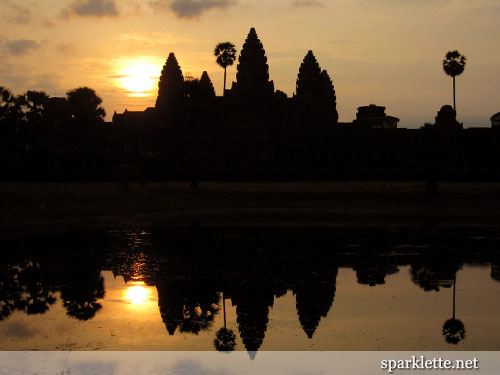
After waiting half an hour, we did get to see the sun peeking out from behind Angkor Wat. We also caught a reflection of the magnificent monument in the pond. It was amazing!
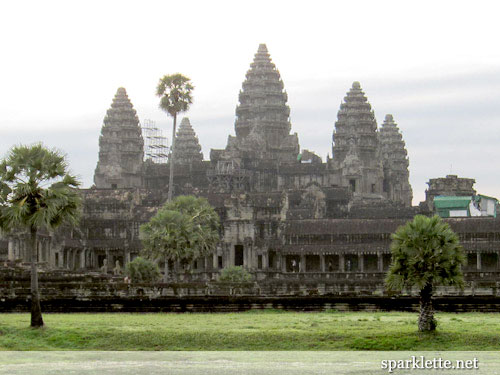
Another advantage of visiting the temple in the early morning is that the temperature then is more bearable. During this time of the year, it can easily soar to 35 degrees Celsius or even higher!
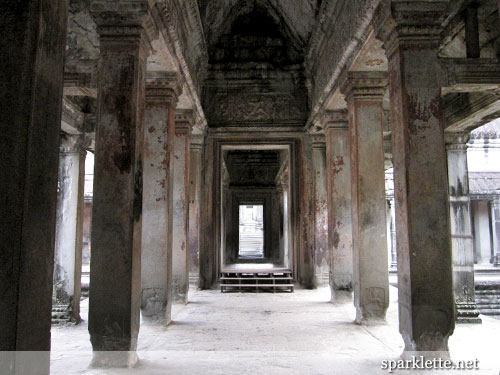
Here’s an inside peek of Angkor Wat. The temple was constructed in the early 12th century as a Hindu monument, before being converted to one of Buddhism in the late 13th century.
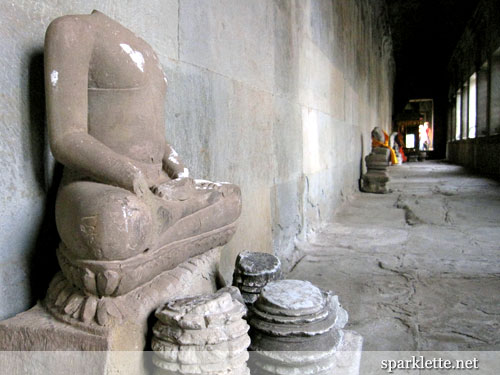
While you would find that most of the statues are headless, the result of pillaging and looting, the temple still carries pillars, towers and wall motifs that have been left intact.
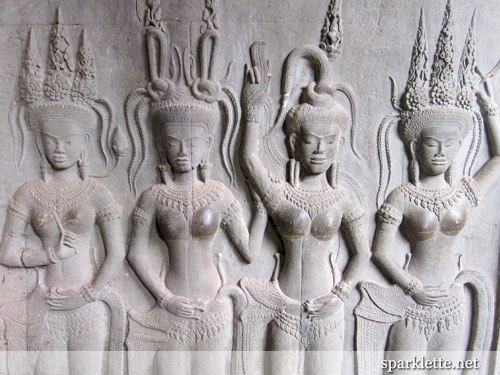
Exquisite bas-reliefs decorate the walls, a display of the artisans’ skilful craftsmanship that were way ahead of their time! The ones above feature devatas (minor female deities).
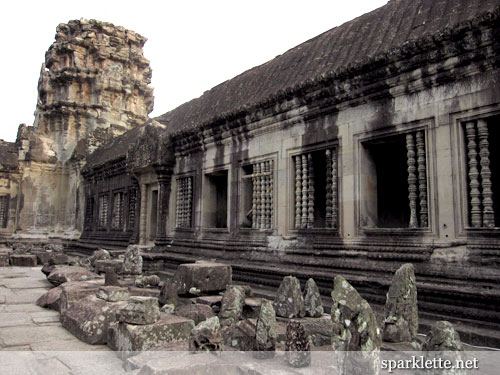
“Gallery” is the term used to describe the passageway lining the sides of an enclosure or the temple itself. We explored the temple mostly by walking through such galleries. The air can get pretty musty at times, and at certain spots there’s even the stale smell of urine.
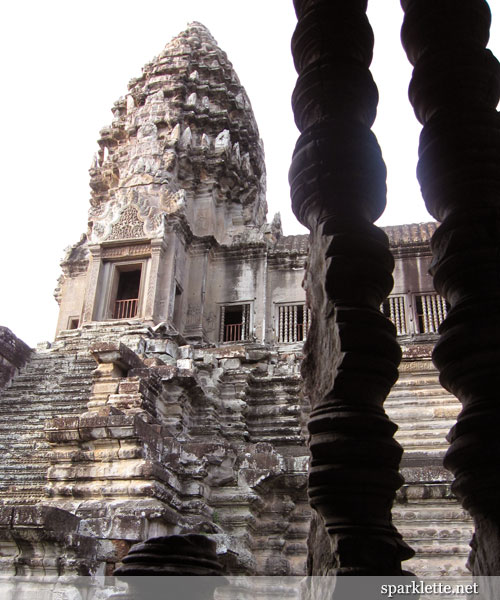
The towers at the central sanctuary are shaped like lotus buds. Check out those killer steps! They bring back memories of the ones we braved at Wat Arun! The steepness signifies the difficulty of climbing the “stairway to heaven”. In fact, the height of each step is longer than its tread, creating an angle of ascent that is bigger than 45 degrees! *shudders*
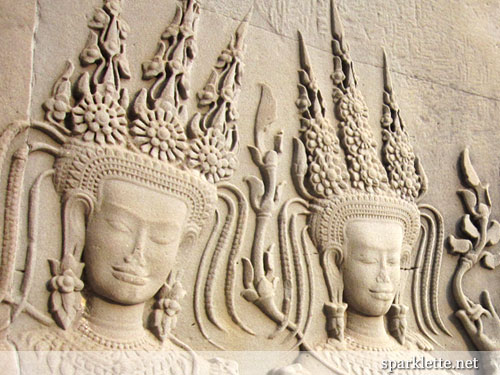
Despite centuries of wear and tear and invasions from looters and tourists, the bas-reliefs have well stood through the test of time and remain beautiful even today.
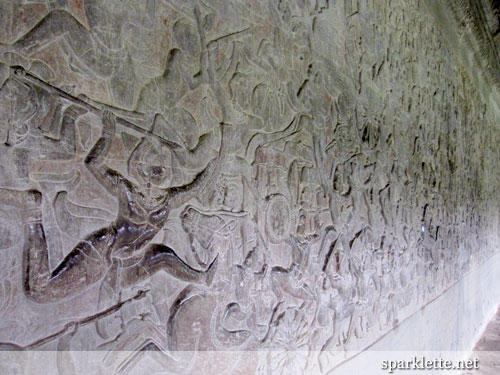
These reliefs adorning the walls illustrate the ancient battle of Kurukshetra. Such reliefs occupy more than 1000 square metres on the gallery walls. Imagine the amount of labour that must have gone into them!
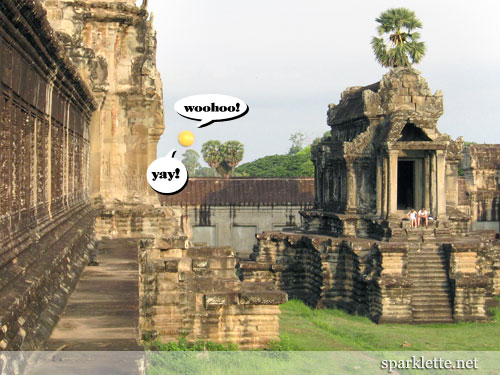
While walking along the galleries, we spotted a giant helium balloon in the distance carrying passengers into the air. Doesn’t it remind you of the DHL balloon?
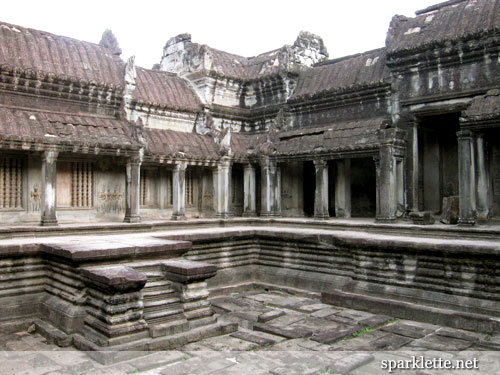
During our tour of the temple, we had a few encounters of locals blocking our way. They would give out joss sticks, make us pray and give them donations before letting us pass. We declined, of course. Tourist trap much?
Ready to move on to our next destination, we left the temple compounds, but not before snapping this picture of a monk. He was, rather amusingly, posing for a cameraman. I think they were shooting photographs for postcards! What do you think?
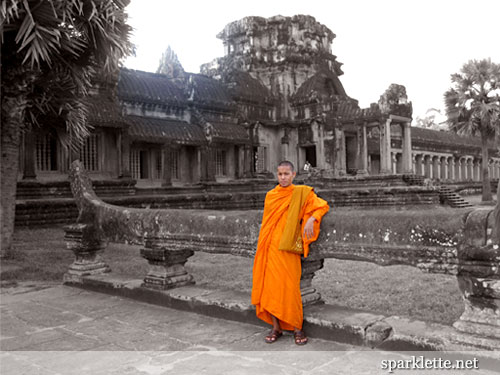
(We actually visited Angkor Wat again the following day. This time round Mr. Sohmat dropped us off at a different location and we ended up in a forest (!!) with the temple nowhere in sight (!!!). We followed a mud path rather nervously for a while before finally coming to this:

Angkor Wat! Having walked that long deserted path through the forest, it really felt as though we had discovered Angkor Wat, if you know what I mean! It was fun to pretend for a while that *we* found the great Angkor Wat.
If you’re curious to check out this alternative way into Angkor Wat, it is the back entrance to the East that virtually no one uses.)
Upon exiting Angkor Wat, we used our all-seeing eyes to seek out Mr. Sohmat in the sea of identical tuk-tuks. During this time we were swamped by local children asking us to buy stuff, again speaking in fluent English. They were so cute that sometimes it’s really hard to say no. No wonder Angelina Jolie adopted maddox :)
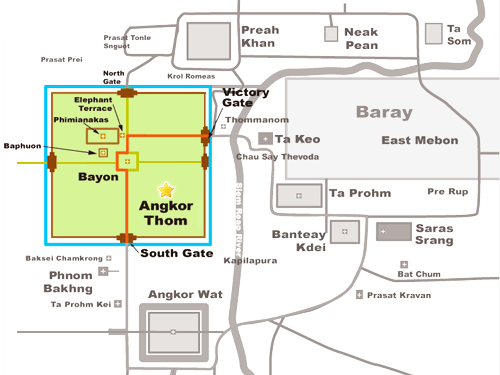
Our next pit-stop was the aforementioned Angkor Thom. As you can see, it occupies a much larger area than Angkor Wat. That’s because it is in fact a city by itself, the last capital of the Khmer empire.
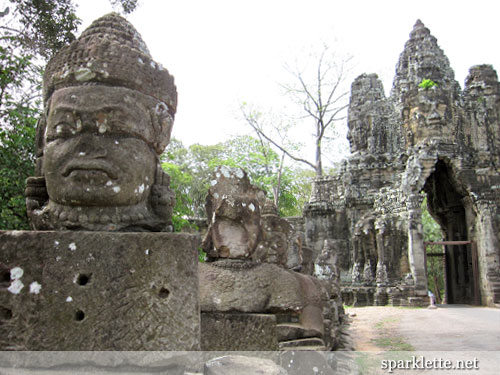
Leading up to the city gate is a bridge that stretches across a moat, with long rows of larger-than-life statues, including some headless ones, lining either side. We had been staring at nothing but foliage and the occasional monkey while riding on the tuk-tuk, so when this rare sight appeared before us it was certainly a big “wow” moment!
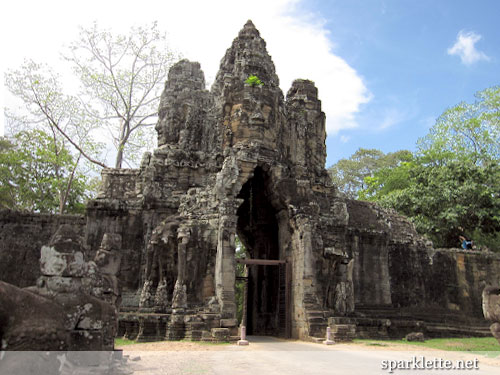
The city gate is an immense 23 metre tall structure. At any one time, only one vehicle can pass through its narrow entrance. Can you spot its face? It is the first sign of what we are going to see in the state temple of the Bayon.
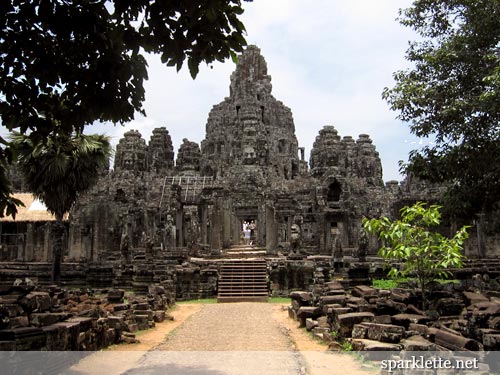
The Bayon is by far my most favourite temple in Cambodia. From afar, it looks just like another massive pile of ruins. But as I drew closer and the faces started appearing amidst the stone towers, that’s when it hit me that I was in the presence of something really incredible.
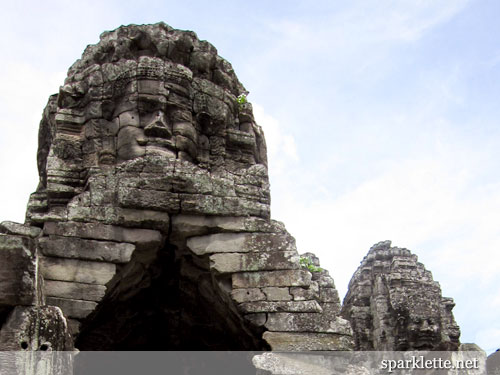
With 37 four-faced towers still standing today (from the original 54), there are more than a hundred carved faces to look out for! Exactly who these faces depict remains a mystery.
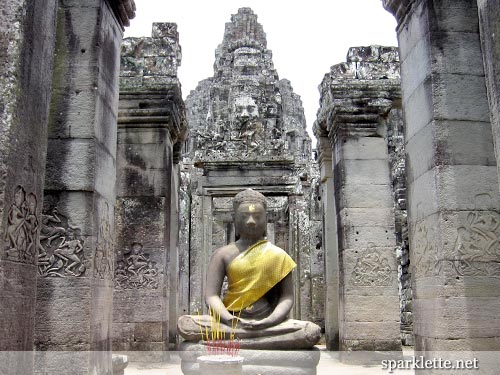
The pillars on the lower level are carved with reliefs, many depicting the everyday life of the 12th century.
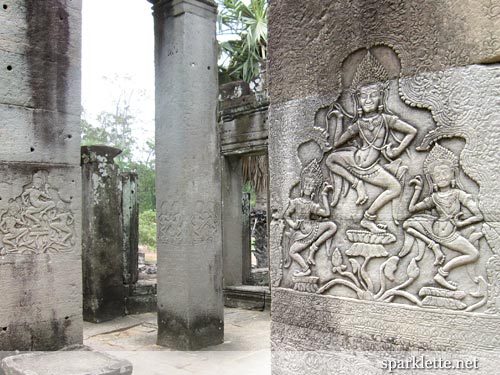
The reliefs above show groups of apsaras (celestial dancing girls). Within the Bayon, the reliefs span over 1.3 kilometres with more than 11,000 figures!
The lower levels of the temple are filled with many crevices and narrow passageways arranged pretty much haphazardly. It’s like a maze that would surely bring out the adventurer in many of us.
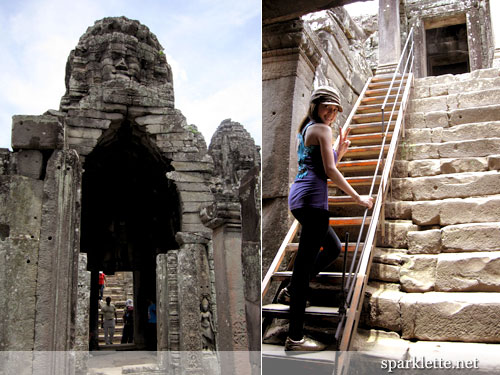
To reach the upper level, we had to climb up small steep staircases, one person at a time. To preserve the stone steps, metal staircases have been built over them. There are at least two such staircases, but only this particular one has a handrail! Look for this one ;)
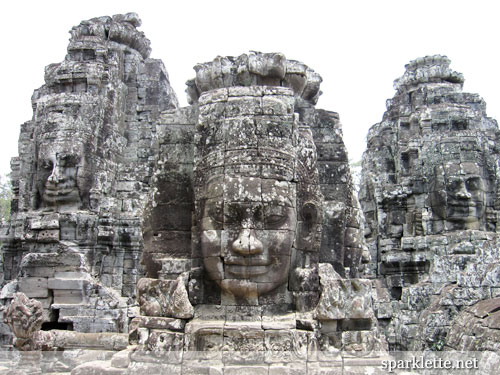
At the top, you can get up close and personal with the enormous faces.
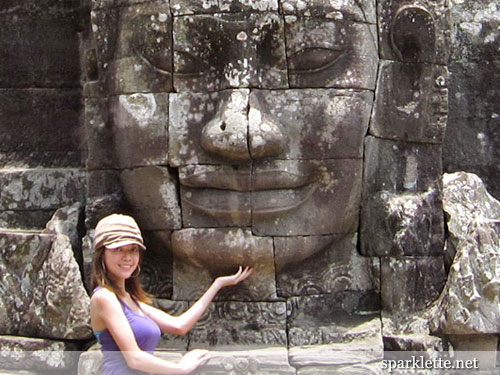
That’s me giving one of them a scratch on the chin. Why? Because everyone deserves a good scratch once in a while!
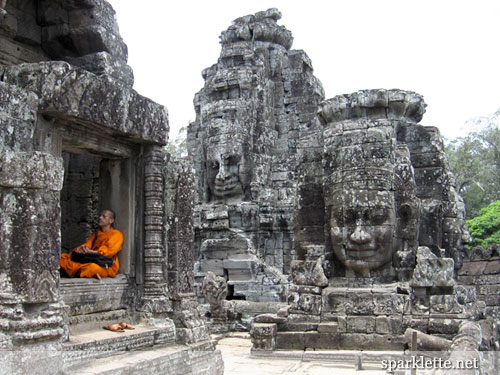
Look, I even found a monk resting there! He really completes the picture, don’t you think?
Having visited two monumental temples back-to-back, I found myself preferring the bayon to Angkor Wat. While Angkor Wat is by far the bigger and more majestic temple, the Bayon’s four-faced towers make it more unique and special, certainly one of the most impressive temples ever.
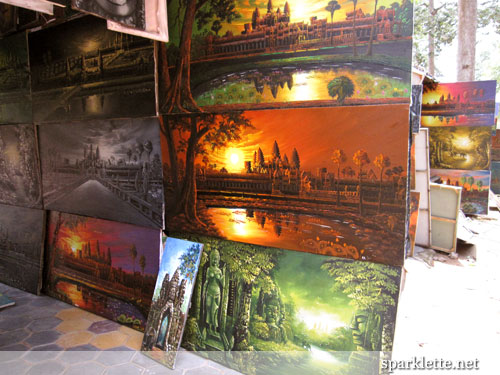
By the time we were out of the Bayon, it was past noon. The weather was scorching hot and we had to make a stop at the nearby stretch of eateries for a quick pick-me-up. Canned coca-cola drinks were a “dollah” each. Alongside were small stalls selling tourist souvenirs and beautiful paintings of Angkor Wat and the Bayon.
Moving on, we took a walk to Baphuon, the former state temple of Angkor Thom. After walking a long elevated walkway, we ended up at the closed entrance with a sign stating that the temple is closed for a restoration project. We didn’t fret, but went round the temple to find this instead. Can you tell what it is?
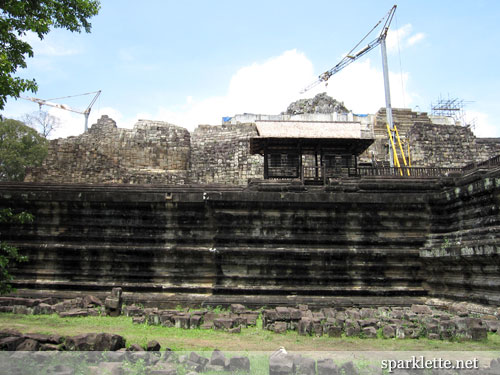
It’s the sleeping Buddha! A huuuge one at that.

On our way back out, we noticed a few water buffalo grazing by a small pool. Noting how focused they were on the grass-munching action, I courageously went ahead and took a photo of them. They didn’t attack me like the geese did. Phew!
Soldiering on bravely in the hot, hot, hot Cambodian heat, we arrived at the Elephant Terrace.
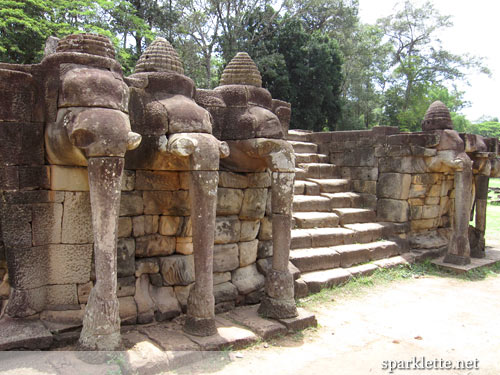
Spanning a distance of 350 meters, the terrace was used as a giant viewing platform for ceremonies in its heyday. It also marks the way to the royal palace. Ta-da!
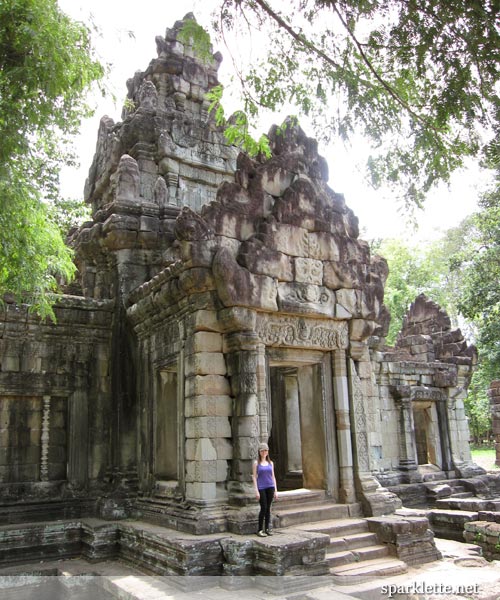
That’s a very tiny-looking me standing at the entrance of the royal palace. That gate is massive!!!
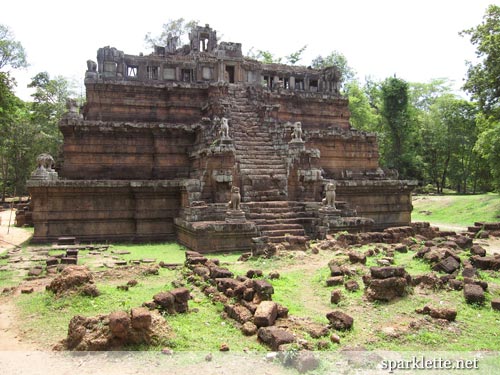
Today, the only thing that remains of the royal palace is this step pyramid, the Phimeanakas.
Satisfied with our temple-sightseeing accomplishments for the day, we met Mr. Sohmat again to leave Angkor. We often wondered what he was doing while we were scrambling over the ruins. Was he chit-chatting with other tuk-tuk drivers? Enjoying an afternoon beer perhaps?
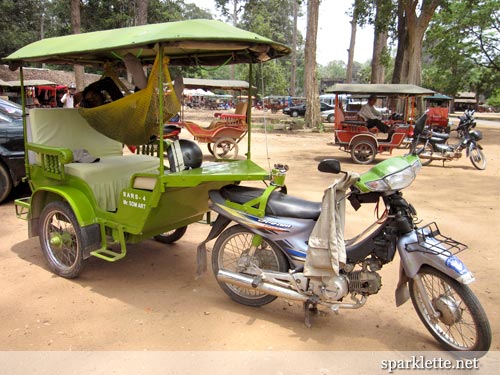
We had our answer when we found him napping in his handy hammock! How very summery!
With that, we left the ruins of Angkor. Wait, before you ask, “what? 200 temples and all you saw were two?” rest assured that we spent the better part of the following day visiting a few more of them.
But for that afternoon onwards, we were keen to begin our next phase of (more relaxing) activities. Check out Part 2!
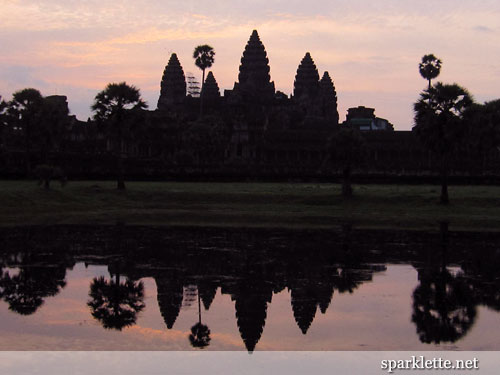

May 30, 2009
5
Hi. Seldom see you featured in your own blog. You look pretty there. Where should I go for my holidays.. hmm..
Jun 1, 2009
3472
Thanks! The main *star* of the blog is all the food that I review and the places I’ve visited, so there’s no need to cam-whore too much. Haha
Jun 1, 2009
72
Beautifully taken photographs of the two Angkor temples, and the Bayon one with the monk is a classic. I have visited Siem Reap twice (for work purposes), and its charms never fail to beguile me. The other places with memorable temples is Sukhothai in Thailand (middle part), the old kingdom, and Bayon in Myanmar which has more than a thousand pagodas, shrines and temples.
I suppose you will be blogging about Banteay Srei next (I hope)? We do have an image of it in our Asian Civilisations Museum, which shows the effects of sunlight casting shadows through the day.
Jun 3, 2009
3472
Oh yes, we visited Banteay Srei. It’s a lot further away from Siem Reap when you compare it with Angkor Wat and Angkor Thom. And it’s also the prettiest! I would be blogging about it in an upcoming post.
I wonder whether you have visited the Angkor National Museum? The feel of it, the layout and all, reminds me very much of our Asian Civilisations Museum! You can see the photos in my following post.
Jun 1, 2009
72
yeah, its the first time i notice you actually posing in your blog pics!
I like how you de-saturated the colours in the first pic of the standing monk to highlight the intensity of his orange robe.
Quite surprised it seemed so empty of tourists in your photos – unless you actually waited till the scene was clear of people to take the snaps.
I can’t wait to visit Angkor Wat in December! I was already in awe at the miniature version of Preah Vihear in Muang Boran, so seeing the real Khmer architecture and bas-reliefs should be amazing :)
Jun 3, 2009
3472
Ah yes, I waited until everyone walked away before I snapped the shots. You’re a sharp one for noticing that. I like my photos to depict the actual monuments as they are, with their details unblocked by anyone. And sometimes I had to be really patient to wait for that.
Jun 2, 2009
31
Wow!! All your photos were amazing!! You will definitely win prizes if you submit them for competition! I love the “reflection of the magnificent monument in the pond” especially! Awesome!!
Jun 3, 2009
3472
Thanks! I still wish that I had captured the colours and intricate details of the monument in those reflection photos. But I guess it’s not that easy with my compact camera.
Jun 11, 2009
7
Hi Veron,
What time did you have to leave for the temples to catch the sunrise?
Jun 11, 2009
3472
We set off from our resort at 5:30am. We still had ample time to find a good spot when we got there.
Jun 12, 2009
7
Thanks for the info. I noticed that you brought a temple pass on day 2. Did you have to buy another temple pass for your visit on day 3?
Jun 13, 2009
3472
Yes we bought a pass on both days (2 x US$20). If you’re going there for 3 days, you can get the 3-day pass at US$40.
Jun 14, 2009
7
Thanks much… I am so looking forward to my trip in August. Hope it is as fun as yours is! =]
Jun 16, 2010
2
hi…i m going to Siem Reap on this coming October..i would like to ask u that pass on both days (2 x US$20) ? so u mean the entry pass for 2 days was also USD$20 ? i thought USD $20 is just for 1 day ? if 2 day is need pay USD$40 as like 3 days pass price..
Jun 17, 2010
3472
Yes. If the fee hasn’t changed, it would still be $20 for a day, and $40 (2 x 20) for 2 days.
Jun 21, 2010
2
Hi..me and my friends will going to Siem Reap for 3 days..i think i might jus get the 1day Pass for Angkor Wat..here the highlight i do want to visit after view your blog..will start on 5am for there to see the sunrise Angkor Wat, Angkor Thom and Bayon, Banteay Srei Temple ( the lady’s temple ), Ta Som , Preah khan, Ta Prohm( the Tomb Raider temple),Banteay Samre from your opion do u think we can finish it by 1 day ?
May 16, 2010
1
Hi,
Intend to visit Cambodia in Aug’10. Need some advice from you.Is it convenient to move around from temple to temple? how do u get reliable tuk tuk uncle? can they be our guide or engage them for my 3 days trip?
May 19, 2010
3472
I think most of the tuk tuk drivers are just that. They drive you around and will wait for you outside the temple to drive you to the next destination. I doubt any of them can double as guides. If you need a tour guide, you need to do some research online to find a good one.
Dec 28, 2010
2
Planning a trip to Cambodia next year and I was wondering whether I could visit Angkor Wat and Angkor Thom in a day and your post certainly answered that question. Very useful post and great photos! Thanks :)
Aug 17, 2012
1
Beautiful site and pictures!
Nov 5, 2012
1
Great photos and I have just one question; How did you manage to get photos without the hoards of tourists in it??
Nov 5, 2012
3472
With patience and the right timing :) At times I would wait until people walked away before quickly snapping the shots.
Jan 9, 2015
1
Hi, do you have Mr Sohmat’s contact number? How do you contact him? Via email? Hope to hear from you soon :)